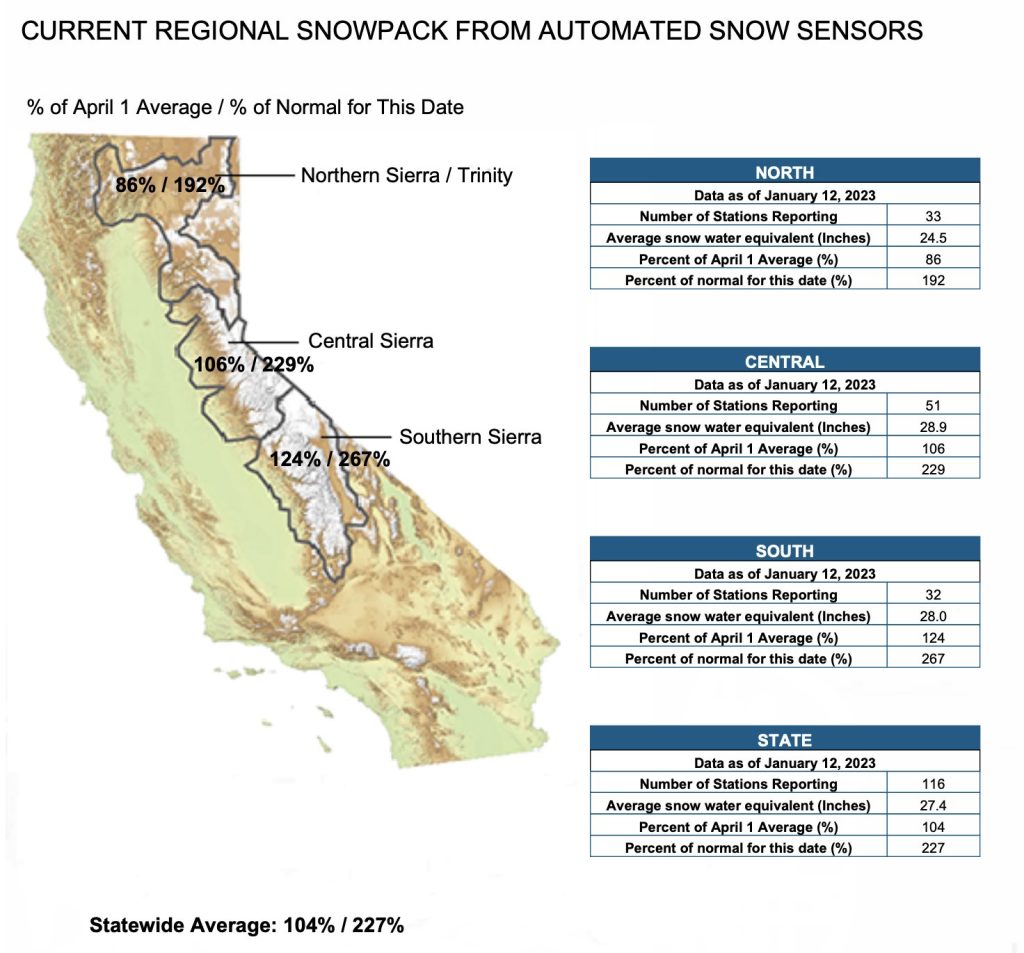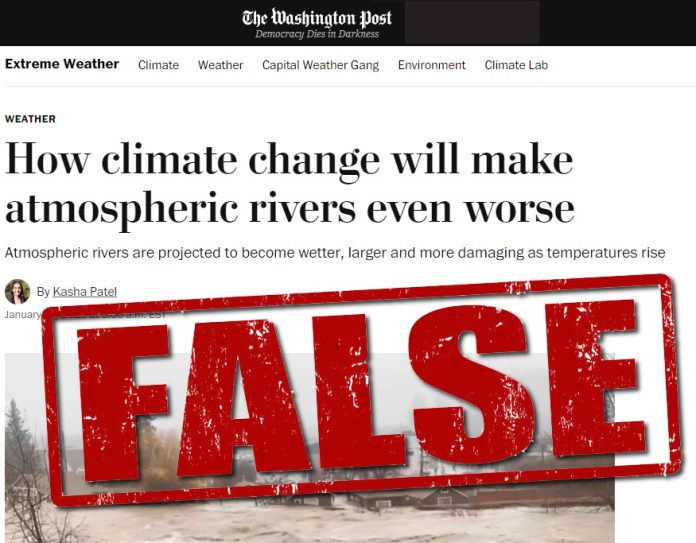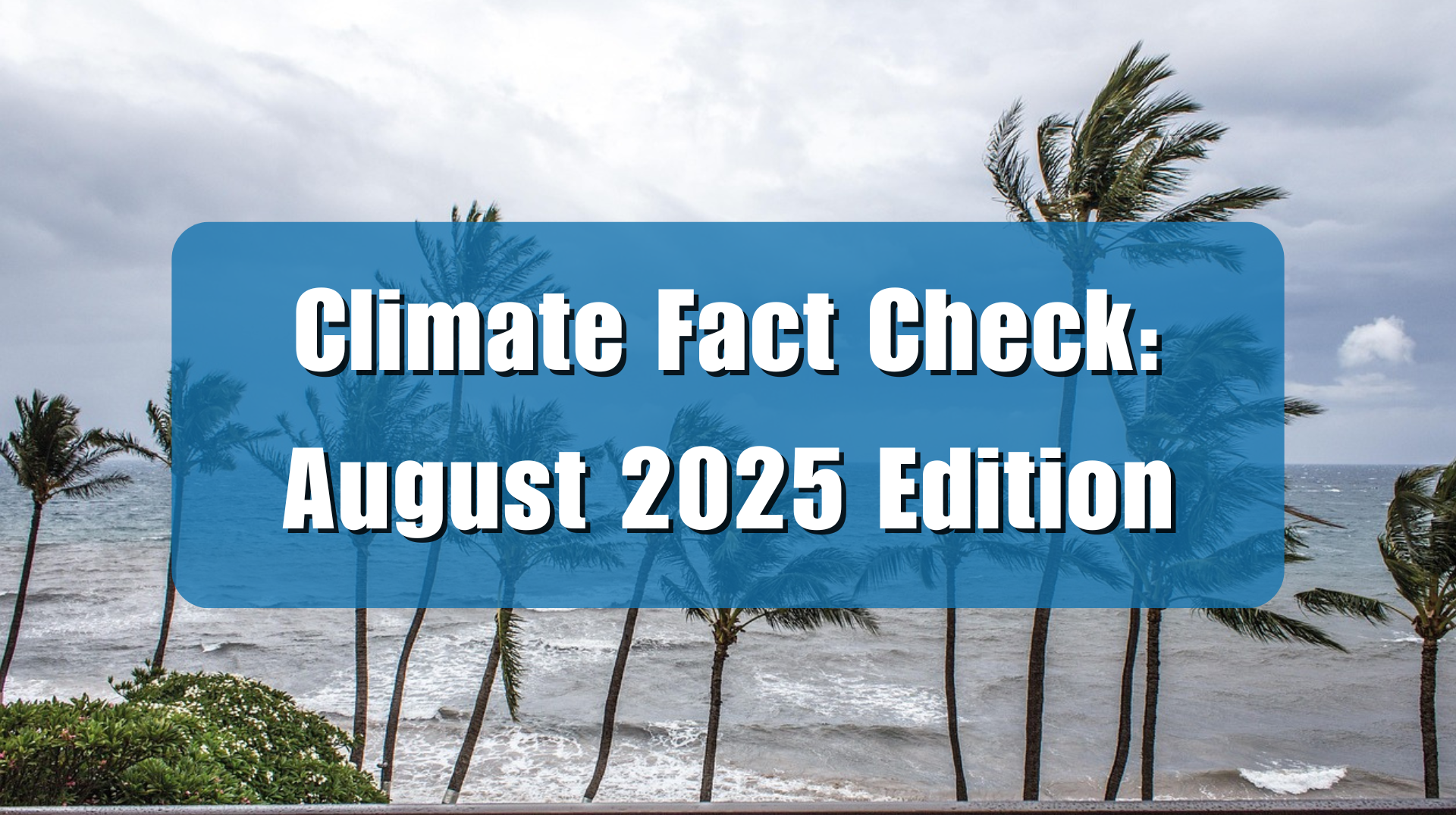On January 12, 2023, The Washington Post (WaPo) published a story by writer Kasha Patel with the headline, How climate change will make atmospheric rivers even worse. In the story Patel claimed, “Atmospheric rivers are projected to become wetter, larger and more damaging as temperatures rise.” Headline-wise, nothing could be further from the truth. Historical and current real-world data provide no evidence that climate change has made atmospheric rivers more frequent or severe, nor do they provide a causal connection indicating why it should do so.
This first claim is supposedly heavier rainfall. WaPo says:
Perhaps one of the most well-understood aspects of climate change is its effect on rain. In a warmer atmosphere, evaporation rates increase and transform more liquid water molecules to a vapor state in the air. In fact, the atmosphere can hold about 7 percent more water for every 1-degree Celsius (1.8-degree Fahrenheit) increase. This moisture-laden air can drop heavier amounts of rainfall at one time, increasing the intensity of rain events.
Earth’s atmosphere has warmed about 1.3 degrees Celsius (2.3 degrees Fahrenheit) since pre-industrial times, and researchers have already observed heavier rain in storms, hurricanes, daily precipitation — and now in atmospheric rivers.
While it is true that warmer air holds more moisture, WaPo’s claims about storms, hurricanes and daily precipitation being worse are completely false.
Chapter 11, Weather and Climate Extreme Events in a Changing Climate, of the Intergovernmental Panel on Climate Change (IPCC) AR6 report, concludes that changes in the frequency and intensity of most severe weather events have not been detected nor can any changes be attributed to human caused climate change.
Regarding storms that depend on the global atmospheric water cycle, real world data shows that there has been no increase no increase in flooding; no increase in tropical cyclones and hurricanes; no increase in winter storms; and no increase in thunderstorms or tornadoes, or associated hail, lightning, and extreme winds from thunderstorms.
Further, a peer-reviewed paper published in 2020 used satellite and sounding data and found there has been no trend influencing tropical lower stratospheric water vapor, in the region these west coast atmospheric rivers originate.
Even more powerful than that, a data analysis of global relative humidity data over the land and oceans (where atmospheric rivers originate) and publicly available from the UK Met Office, shows relative humidity actually declining.

Having swung and missed badly on its claims that severe weather is getting worse, WaPo then absurdly claims there will be less snow, while falsely claiming atmospheric rivers will be worse:
Atmospheric rivers play a critical role in supplying mountain snowpack, which serves as an important source of freshwater as it melts in the spring and summer. Some research shows the weather systems provide about a quarter of the snowpack in the Sierra Nevada. Yet as temperatures rise, snowfall is decreasing.
Studies have already shown atmospheric rivers are delivering less snow in the northern Sierra Nevada, instead falling as rain because of Earth’s excess warmth.
This is false. The most recent series of atmospheric rivers from December 2022 into January 2023 have delivered massive amounts of snow to California.
According to the California Department of Water Resources, the snowpack in the Central and Southern Sierra regions is currently more than 200 percent above average for this date and 76% of the April 1 average, when it typically reaches its peak.
The UC Berkeley Central Sierra Snow Lab shared a map (see figure 2 below) that showed that as of January 12th, the snowpack in California was doing very well, saying, “Looking at the state as a whole, we are now 104% of our April 1 average according to @CA_DWR!”

Patel also fails to mention California’s history related to flooding from atmospheric rivers, yet paleoclimate history rebukes her claims even more powerfully than contemporary data.
California has always been prone to atmospheric river related severe weather events. From late 1861 into January 1862, the largest-ever atmospheric river event hit the west coast.
Known as the Great Flood of 1862, it was the largest in California’s recorded history. Weeks of continuous rains and snows in high elevations began November 1861 and continued into January 1862. This was followed by a record amount of rain from January 9 to 12. The atmospheric river event dumped an equivalent of 10 feet of water on California, combining rain and snow, over 43 days.
At the end, a warm intense storm melted the heavy snow load, causing flooding throughout the Sacramento valley, including Sacramento itself, see the Figure 3 lithograph. The capital was moved to San Francisco, the state was bankrupted, and government workers received no pay for nearly a year. Much of California’s Central Valley became a lake — 300 miles long; up to 40 miles wide.

Geologists at the U.S. Geological Survey (USGS) have drilled to get core samples in San Francisco Bay and in lake and marsh sediments throughout California. They positively identified the stream gravels deposited by the Great Flood of 1862. They also discovered that similar and even more devastating flooding occurred in AD 212, 440, 603, 1029, 1418, and 1605 — roughly every 200 years.
In that publication, the USGS said research on past atmospheric river events has found: “The geologic record shows 6 megastorms more severe than 1861-1862 in California in the last 1800 years, and there is no reason to believe similar events won’t occur again.”
The question that WaPo won’t answer is – how did all these stronger storms happen before so-called modern man-made climate change?
The answer is – WaPo and much of climate science today is overly reliant on projections from computer models rather than looking at trends in historical and real-world data.
As computer models projections of temperatures show, climate models are too unreliable to based predictions on. Unfortunately, rather than doing some independent research and fact checking, putting the “investigation” into investigative journalism, writers like Patel, and mainstream media outlets like WaPo, continue to support the thoroughly refuted but widely promoted narrative that climate change is making weather worse. Shame on them for stubbornly clinging to a false narrative in order to promote fear.





















